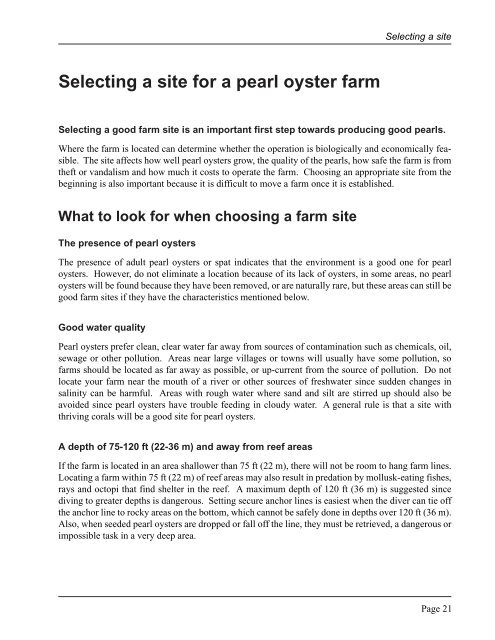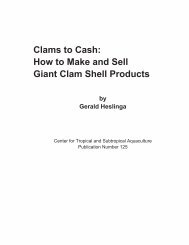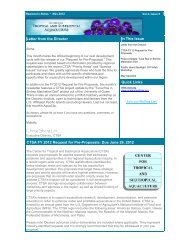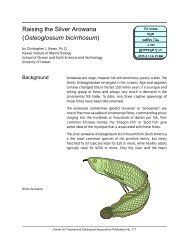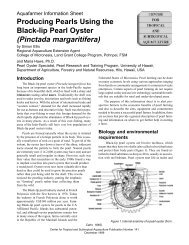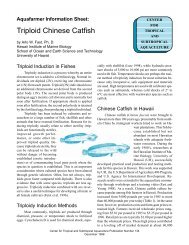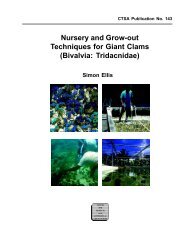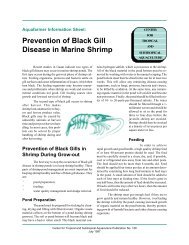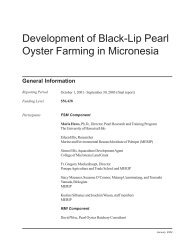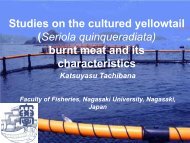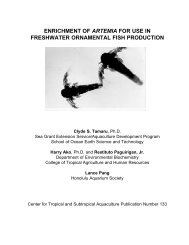The Basic Methods of Pearl Farming: A Layman's Manual - CTSA
The Basic Methods of Pearl Farming: A Layman's Manual - CTSA
The Basic Methods of Pearl Farming: A Layman's Manual - CTSA
You also want an ePaper? Increase the reach of your titles
YUMPU automatically turns print PDFs into web optimized ePapers that Google loves.
Selecting a siteSelecting a site for a pearl oyster farmSelecting a good farm site is an important first step towards producing good pearls.Where the farm is located can determine whether the operation is biologically and economically feasible.<strong>The</strong> site affects how well pearl oysters grow, the quality <strong>of</strong> the pearls, how safe the farm is fromtheft or vandalism and how much it costs to operate the farm. Choosing an appropriate site from thebeginning is also important because it is difficult to move a farm once it is established.What to look for when choosing a farm site<strong>The</strong> presence <strong>of</strong> pearl oysters<strong>The</strong> presence <strong>of</strong> adult pearl oysters or spat indicates that the environment is a good one for pearloysters. However, do not eliminate a location because <strong>of</strong> its lack <strong>of</strong> oysters, in some areas, no pearloysters will be found because they have been removed, or are naturally rare, but these areas can still begood farm sites if they have the characteristics mentioned below.Good water quality<strong>Pearl</strong> oysters prefer clean, clear water far away from sources <strong>of</strong> contamination such as chemicals, oil,sewage or other pollution. Areas near large villages or towns will usually have some pollution, s<strong>of</strong>arms should be located as far away as possible, or up-current from the source <strong>of</strong> pollution. Do notlocate your farm near the mouth <strong>of</strong> a river or other sources <strong>of</strong> freshwater since sudden changes insalinity can be harmful. Areas with rough water where sand and silt are stirred up should also beavoided since pearl oysters have trouble feeding in cloudy water. A general rule is that a site withthriving corals will be a good site for pearl oysters.A depth <strong>of</strong> 75-120 ft (22-36 m) and away from reef areasIf the farm is located in an area shallower than 75 ft (22 m), there will not be room to hang farm lines.Locating a farm within 75 ft (22 m) <strong>of</strong> reef areas may also result in predation by mollusk-eating fishes,rays and octopi that find shelter in the reef. A maximum depth <strong>of</strong> 120 ft (36 m) is suggested sincediving to greater depths is dangerous. Setting secure anchor lines is easiest when the diver can tie <strong>of</strong>fthe anchor line to rocky areas on the bottom, which cannot be safely done in depths over 120 ft (36 m).Also, when seeded pearl oysters are dropped or fall <strong>of</strong>f the line, they must be retrieved, a dangerous orimpossible task in a very deep area.Page 21


